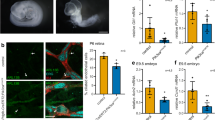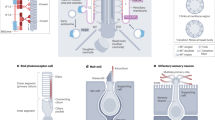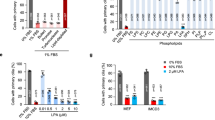Abstract
The primary cilium is an antenna-like structure that protrudes from the cell surface of quiescent/differentiated cells and participates in extracellular signal processing1,2,3. Here, we report that mice deficient for the lipid 5-phosphatase Inpp5e develop a multiorgan disorder associated with structural defects of the primary cilium. In ciliated mouse embryonic fibroblasts, Inpp5e is concentrated in the axoneme of the primary cilium. Inpp5e inactivation did not impair ciliary assembly but altered the stability of pre-established cilia after serum addition. Blocking phosphoinositide 3-kinase (PI3K) activity or ciliary platelet-derived growth factor receptor α (PDGFRα) restored ciliary stability. In human INPP5E, we identified a mutation affecting INPP5E ciliary localization and cilium stability in a family with MORM syndrome, a condition related to Bardet-Biedl syndrome. Together, our results show that INPP5E plays an essential role in the primary cilium by controlling ciliary growth factor and PI3K signaling and stability, and highlight the consequences of INPP5E dysfunction.
This is a preview of subscription content, access via your institution
Access options
Subscribe to this journal
Receive 12 print issues and online access
$209.00 per year
only $17.42 per issue
Buy this article
- Purchase on SpringerLink
- Instant access to full article PDF
Prices may be subject to local taxes which are calculated during checkout




Similar content being viewed by others
References
Adams, M., Smith, U.M., Logan, C.V. & Johnson, C.A. Recent advances in the molecular pathology, cell biology and genetics of ciliopathies. J. Med. Genet. 45, 257–267 (2008).
Christensen, S.T., Pedersen, L.B., Schneider, L. & Satir, P. Sensory cilia and integration of signal transduction in human health and disease. Traffic 8, 97–109 (2007).
Anderson, C.T. et al. Primary cilia: cellular sensors for the skeleton. Anat. Rec. 291, 1074–1078 (2008).
Blero, D., Payrastre, B., Schurmans, S. & Erneux, C.E. Phosphoinositide phosphatases in a network of signaling reactions. Pflugers Arch. 455, 31–44 (2007).
Astle, M.V., Horan, K.A., Ooms, L.M. & Mitchell, C.A. The inositol polyphosphate 5-phosphatases: traffic controllers, waistline watchers and tumour suppressors? Biochem. Soc. Symp. 74, 161–181 (2007).
Asano, T., Mochizuki, Y., Matsumoto, K., Takenawa, T. & Endo, T. Pharbin, a novel inositol polyphosphate 5-phosphatase, induces dendritic appearances in fibroblasts. Biochem. Biophys. Res. Commun. 261, 188–195 (1999).
Kisseleva, M.V., Wilson, M.P. & Majerus, P.W. The isolation and characterization of a cDNA encoding phospholipids specific inositol polyphosphate 5-phosphatase. J. Biol. Chem. 275, 20110–20116 (2000).
Kong, A.M. et al. Cloning and characterization of a 72-kDa inositol-polyphosphate 5-phosphatase localized to the Golgi network. J. Biol. Chem. 275, 24052–24064 (2000).
Pan, J., Wang, Q. & Snell, W.J. Cilium-generated signalling and cilia-related disorders. Lab. Invest. 85, 452–463 (2005).
Singla, V. & Reiter, J.F. The primary cilium as the cell's antenna: signalling at a sensory organelle. Science 313, 629–633 (2006).
Badano, J.L., Mitsuma, N., Beales, P.L. & Katsanis, N. The ciliopathies: an emerging class of human genetic disorders. Annu. Rev. Genomics Hum. Genet. 7, 125–148 (2006).
Ong, A.C. & Wheatley, D.N. Polycystic kidney disease: the ciliary connection. Lancet 361, 774–776 (2003).
Lin, F. et al. Kidney-specific inactivation of the KIF3A subunit of kinesin-II inhibits renal ciliogenesis and produces polycystic kidney disease. Proc. Natl. Acad. Sci. USA 100, 5286–5291 (2003).
Schneider, L. et al. PDGFRαα signaling is regulated through the primary cilium in fibroblasts. Curr. Biol. 15, 1861–1866 (2005).
Hayashi, S. & McMahon, A.P. Efficient recombination in diverse tissues by a tamoxifen-inducible form of Cre: a tool for temporally regulated gene activation/inactivation in the mouse. Dev. Biol. 244, 305–318 (2002).
Phillips, C.L. et al. Renal cysts in inv/inv mice resemble infantile nephronophthisis. J. Am. Soc. Nephrol. 15, 1744–1755 (2004).
Hampshire, D.J. et al. MORM syndrome (mental retardation, truncal obesity, retinal dystrophy and micropenis), a new autosomal recessive disorder, links to 9q34. Eur. J. Hum. Genet. 14, 543–548 (2006).
Beales, P.L., Warner, A.M., Hitman, G.A., Thakker, R. & Flinter, F.A. Bardet-Biedl syndrome: a molecular and phenotypic study of 18 families. J. Med. Genet. 34, 92–98 (1997).
De Smedt, F., Boom, A., Pesesse, X., Schiffmann, S.N. & Erneux, C.E. Post-translational modification of human brain type I inositol-1,4,5-trisphosphate 5-phosphatase by farnesylation. J. Biol. Chem. 271, 10419–10424 (1996).
Kisseleva, M.V., Cao, L. & Majerus, P.W. Phosphoinositide-specific inositol polyphosphate 5-phosphatase IV inhibits Akp/protein kinase B phosphorylation and leads to apoptotic cell death. J. Biol. Chem. 277, 6266–6272 (2002).
Santagata, S. et al. G-protein signalling through tubby proteins. Science 292, 2041–2050 (2001).
Nachury, M.V. et al. A core complex of BBS proteins cooperates with the GTPase Rab8 to promote ciliary membrane biogenesis. Cell 129, 1201–1213 (2007).
Lane, K.T. & Beese, L.S. Structural biology of protein farnesyltransferase and geranylgeranyltransferase type I. J. Lipid Res. 47, 681–699 (2006).
Zhang, P., Li, M.Z. & Elledge, S.J. Towards genetic genome projects: genomic library screening and gene-targeting vector construction in a single step. Nat. Genet. 30, 31–39 (2002).
Hayashi, S. & McMahon, A.P. Efficient recombination in diverse tissues by a tamoxifen-inducible form of Cre: a tool for temporally regulated gene activation/inactivation in the mouse. Dev. Biol. 244, 305–318 (2002).
Vandeput, F., Backers, K., Villeret, V., Pesesse, X. & Erneux, C. The influence of anionic lipids on SHIP2 phosphatidylinositol 3,4,5-trisphosphate 5-phosphatase activity. Cell. Signal. 18, 2193–2199 (2006).
Acknowledgements
We thank C. Erneux, C. Moreau, F. Fontaine and L. Cuvelier for discussions and technical help, S.J. Elledge for the recombineering reagents, A. de Kerchove d'Exaerde for help with the design of the oligonucleotide probes, A. Nagy for the R1 ES cells, A.P. McMahon for the CAGG-Cre-ERTM mice and E. Golemis for hTERT-RPE1 cells. This work was supported by the Fonds de la Recherche Scientifique-FNRS (FRS-FNRS; to S.G. and S.S.), the Fonds pour la Formation à la Recherche dans l'Industrie et dans l'Agriculture (FRIA; to M.J., M.B. and E.P.), the Fonds de la Recherche Scientifique Médicale (FRSM; to S.S. and S.N.S.), the Fondation Rose et Jean Hoguet (to E.P.), Action de Recherches Concertée de la Communauté Française de Belgique (to S.N.S., S.S. and M.B.), The Queen Elisabeth Medical Fundation (to S.N.S.), the Fonds David et Alice Van Buuren (to M.J.), the Royal Society and Cancer Research UK (to F.G.), the American Heart Association (0730350N; to M.V.K.), the US National Institutes of Health (HL16634; to M.V.K.) and the Wellcome Trust (to J.J.C. and C.G.W).
Author information
Authors and Affiliations
Contributions
All authors designed the experiments; M.J., J.J.C., S.G., D.J.H., M.B., E.P., P.C. and D.P.-M. performed experiments; all authors analyzed data; M.J., M.A., M.V.K., F.G., J.H.R. and C.G.W. provided essential reagents and/or biological samples; all authors discussed the results; and S.S. wrote the manuscript with J.J.C. and C.G.W.'s help with the first draft.
Corresponding authors
Supplementary information
Supplementary Text and Figures
Supplementary Figures 1–11 and Supplementary Table 1 (PDF 1524 kb)
Rights and permissions
About this article
Cite this article
Jacoby, M., Cox, J., Gayral, S. et al. INPP5E mutations cause primary cilium signaling defects, ciliary instability and ciliopathies in human and mouse. Nat Genet 41, 1027–1031 (2009). https://doi.org/10.1038/ng.427
Received:
Accepted:
Published:
Issue Date:
DOI: https://doi.org/10.1038/ng.427



